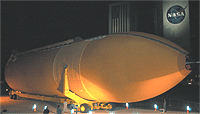The external fuel tank that will help launch the space shuttle Discovery on its next mission arrived two weeks ago at NASA's Kennedy Space Centre.
Designated ET-119, the tank will eventually be mated to the twin white solid rocket boosters and the orbiter Discovery.
NASAanticipates launching the Discovery mission STS-121 in May. But the agency is still working to verify that changes to the design of the shuttle's external tank will result in a safer launch. Upcoming wind tunnel tests are expected to offer important engineering data that will help determine the feasibility of a May launch.
'The thing that is going to speed up getting Discovery off the ground is not work at Kennedy,' space shuttle programme manager Wayne Hale said, 'but the engineering analysis and tests that go toward proving that this launch vehicle is safe to fly.'
In Iowa Joe Gray, leader of the X-ray research group at
Unlike traditional X-rays that make images by transmitting radiation through an object to a detector, backscatter technology creates images based on the electromagnetic radiation deflected by objects back to a detector.
Pieces of the foam fell from the shuttle
When the first shuttle flight since the
NASA is asking Gray and his research team to do an $88,000 (£51,000) three-month study to answer two questions about NASA's foam testing. Gray said engineers want to know more about the ability of X-ray technology to detect bubbles when layers of shuttle foam curve around corners; and about the technology's ability to see any bubbles near the foam's layer lines.
The
Gray said he expects to send NASA a final report on the research this month.





Poll: Should the UK’s railways be renationalised?
Rail passenger numbers declined from 1.27 million in 1946 to 735,000 in 1994 a fall of 42% over 49 years. In 2019 the last pre-Covid year the number...